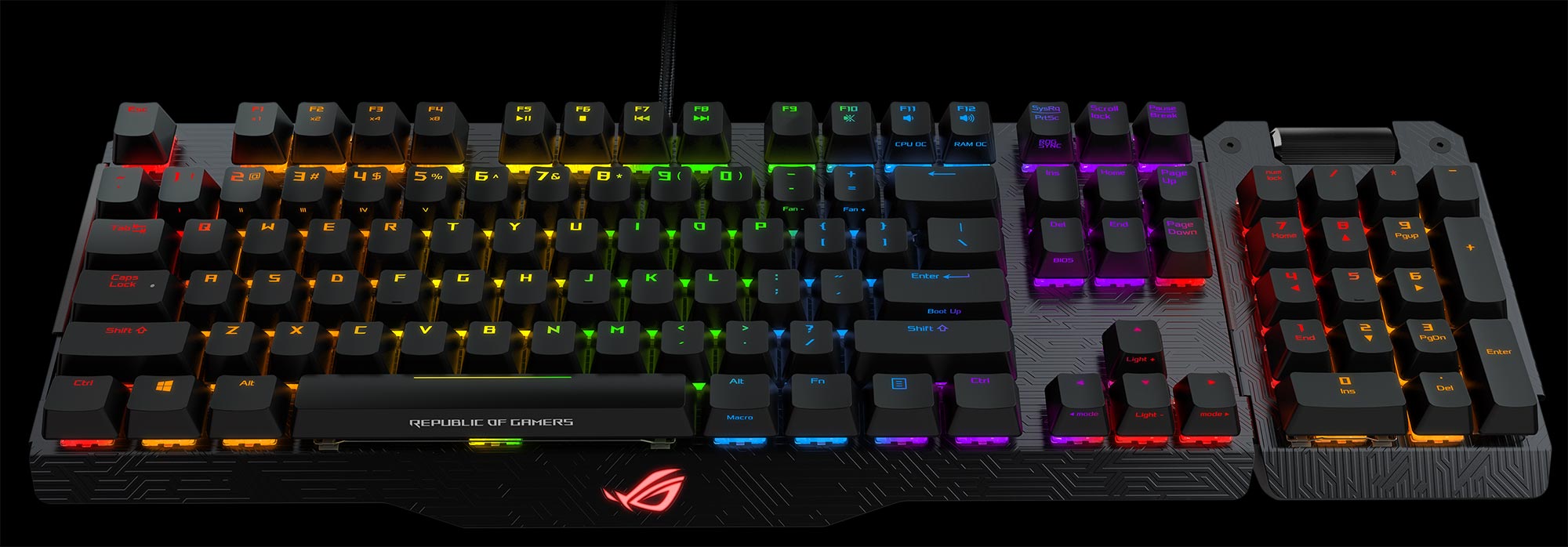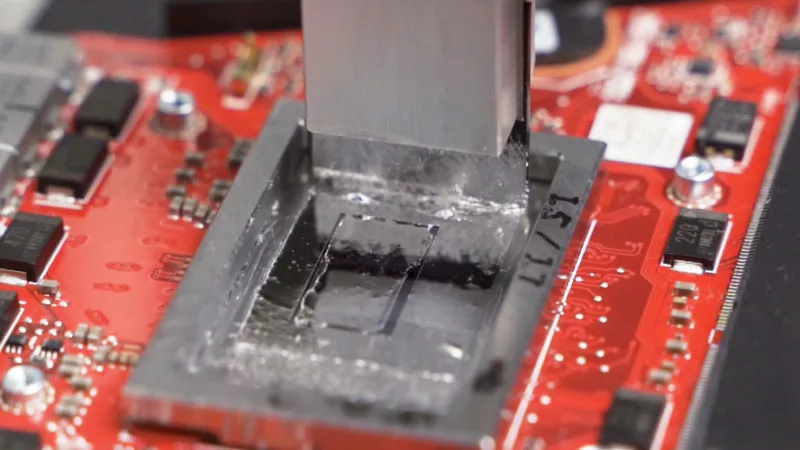The evolution of Aura RGB lighting leads to an official SDK
RGB lighting is the hottest trend in PC gaming hardware. Everyone’s doing it, but if you look at what’s out there, it’s clear that some haven’t fully thought things through. But not ROG. For us, customizable lighting is more than a feature that has to be added because Current Year. It's a uniquely empowering facet of PC personalization that deserves to be nurtured and developed rather than treated like just another checkbox on a feature list.
Our foray into lighting started with the spark of a handful of LEDs on a motherboard. Since then, it's spawned an ecosystem of illuminated products that can synchronize colors and effects across entire PCs based on Aura Sync motherboards. At Computex 2017, we reached beyond the PC and into home lighting via Philips Hue, and we released an SDK that opens up Aura to developers who want to harness PC lighting with their own software.
Humble beginnings rooted in history
As much as the Republic of Gamers relishes boasting about being the first to do something, integrating RGB LEDs into PC hardware wasn't our idea. I'm not even sure it was an idea so much as inevitable progression. PC components and other electronics have long added LEDs for cosmetic and functional ends. Our very first product, the original Crosshair motherboard, employed extra LEDs to cast a distinctive glow and illuminate key areas of the motherboard and I/O cluster, preventing users from fumbling around at dimly lit LAN parties.
As LEDs gained RGB abilities, it was only a matter of time before our motherboards tasted the rainbow. We first added Aura RGB lighting to our Z170 series in 2015. The best of those boards deployed LEDs across multiple zones with independent control. They also complemented the usual cosmetic effects with functional flair, like the ability to map the lighting to audio output and CPU temperatures.
We didn't even make it through the first generation before rolling out an upgrade. Several months after the Z170 launch, the Maximus VII Hero/Alpha because the first motherboard with headers for off-the-shelf "5050" RGB strips. (Told you we like bragging about world's firsts.) Each of the board's dual headers was capable of powering up to two meters of lighting at full brightness, which is enough to light up a full-sized PC both inside and out. That was just the beginning of Aura's evolution.

Support for off-the-shelf RGB strips changed everything
Creating the Aura Sync ecosystem
We took our next step forward with X99 motherboards the following year. These boards featured an updated lighting system dubbed Aura Sync that enabled synchronizing colors and effects across multiple components. The key to making RGB lighting look really good is harmonizing all the LEDs in your system, so we tried to make that as easy as possible. Our software lets you control each component individually or sync the ones you want with just a few clicks. There's no sense in having All The RGBs if it's a hassle getting them to play nicely together.
Aura Sync quickly spread to other ROG hardware, including scores of graphics cards, multiple mice, and our Claymore keyboard and Magnus microphone. We also started working with industry partners to bring their products into the fold. Thanks to our cooperation with In Win, NZXT, Phanteks, Cooler Master, BitFenix, Deep Cool, CableMod, Akasa, EKWB, Cooler Master, Geil, G.Skill, and Zadak, you can get Aura Sync-compatible chassis, light strips, fans, water blocks, memory modules, and SSDs. The final pieces of the puzzle recently fell into place when we introduced the ROG Swift PG27VQ, our first gaming monitor with Aura Sync support, and the Strix Fusion, which extends lighting to headsets. More displays joined the party at Computex, solidifying our lighting solution as the only one capable of covering pretty much every component in your PC.
What do you do when the PC is covered? You think outside the box and into the ambient lighting for the rest of the room. During our ROG press conference at Computex, we announced that Aura Sync will soon be compatible with Philips Hue home lighting. You'll be able to control the color of lamps and bulbs with the same intuitive interface used for your PC, opening up exciting possibilities for battlestations and entire gaming rooms. Best of all, Hue can sync over Wi-Fi, so you won't need to wire external lights to your PC.
Enhancing the lighting itself
In addition to expanding Aura's reach, we've refined its application. The whole point of adding customizable lighting is letting you choose and change your colors at will, so our designers have embraced monochromatic aesthetics that won't clash with your choices. The neutral motifs provide a subtle counterpoint to attention-grabbing illumination, and they make it easier to mix and match components without conflicting colors. We’ve also taken special care to place LEDs in the right places for maximum visibility. Why load up on RGBs if they’re going to be blocked by other components?

Diffused lighting on the Pugio gaming mouse and Rampage VI Extreme motherboard
Our obsession with optimizing also extends to the nature of the glow. Naked LEDs generate localized points of concentrated light that tend to produce lens flares. We all know gamers have seen enough of those, so we're increasingly putting LEDs behind translucent panels that diffuse their output for more even illumination. This isn't always as easy as it sounds. Our Pugio mouse has a curved ring of lighting at the rear that sharply angles up into the body. Making the lighting consistent through the corners of that transition took a lot of work and expertise. We've never shied away from challenges, though. RGB lighting offers such incredible potential that we've started using it to illuminate artistic flourishes. Arguably the best-looking motherboard at Computex this year, the Rampage VI Extreme shows what's possible when LEDs are combined with the right materials and patterns.
With a little embellishment, RGB lighting can be used for interesting 3D effects. Our Poseidon GeForce GTX 1080 Ti graphics card combines mirrors and LEDs to create an illuminated pattern that looks like it stretches into an infinite abyss. A similar technique is used on the new Strix X299-E motherboard, whose central ROG logo almost looks like it's floating over the PCB.

The ROG Poseidon GTX 1080 Ti and In Win 805 illuminate to infinity and beyond
Bring on more programmability
The real allure of RGB LEDs is being able to not just illuminate your PC, but also precisely control how the lighting is used. That's why we're working to expose more programmability on multiple fronts. On the hardware side, many of our new X299 motherboards incorporate a header for addressable strips that offer individual control over each LED on the line. Addressable LEDs need not be in strip form, either. We're working with BitFenix, Cooler Master, Thermaltake, and In Win to produce chassis and fans that incorporate addressable LEDs. The increased control and potential for non-linear LED layouts could revolutionize the way the industry looks at RGB lighting.
Once the hardware is there, you've got to do something with it. Our Aura software is being updated to incorporate fine-tuning controls for addressable LEDs. We're also adding the ability to create customized effects through an easy-to-use interface reminiscent of audio and video editors. Effect customization will extend to all Aura Sync lighting, not just the addressable stuff, to provide another layer of personalization for everyone to explore. In the same vein, we've backported Aura's newer effects to older motherboards to ensure consistency across all Aura Sync boards.
The effect editor won't require programming knowledge, but our new Aura SDK does. It lets developers integrate our lighting into their own applications to provide visual hardware monitoring, illuminated notifications, game-specific functionality, complex effects, and probably loads of other things we haven't thought of yet. You can grab the initial release right now from our Aura SDK site.

An illuminated approach to RGB lighting ready to be unleashed by your imagination
Like all things Aura, the SDK will evolve. Right now, developers can target all the lighting on a given device or class of components. They also have zone-level control to illuminate specific regions. Control over per-key lighting for our Claymore keyboard is coming in a future release. This is especially appealing for gaming, since developers can use colors and effects to provide helpful information on the status of power-ups and other key-bound functions, or which key should be pressed to pay respects. The combination of high visibility, contextual characters, and over 100 individual LEDs makes keyboard lighting intriguing for all kinds of other applications, too. Support for addressable LEDs and Hue home lighting will be added in future SDK releases, as will compatibility with newer products.
Right now, our full-blown Aura software is required to use the SDK and third-party applications that tap into it. The next release will include a separate Aura service that runs in the background to act as a low-profile middleman between the software and hardware, eliminating the need to run the full Aura software package. Along with the SDK, the service will be updated to add support for new products as they come out.
Bright lights, brighter potential
Although we're not ready to make any official announcements just yet, we're already working with high-profile developers to integrate Aura lighting into games and other software. And we're particularly excited to see what the community can do with the SDK. When full-system illumination and eventually room-scale ambient lighting will do your bidding, the possibilities are virtually limitless.
Aura's continued evolution has produced the most capable and attractive full-system lighting system around. But with great power comes great responsibility. While you can use it to tastefully accent a beautiful build, you can also make a gaudy mess of things. The choice is ultimately yours.


